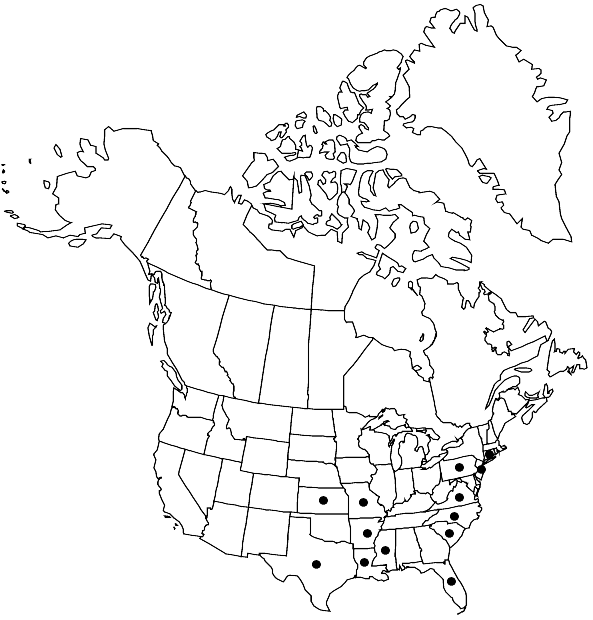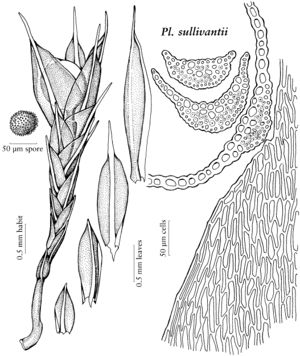Pleuridium sullivantii
Bull. Torrey Bot. Club 6: 142. 1877,.
Stem-leaves appressed, concave, lamina 1-stratose; proximal leaves minute and bractlike, deltoid, acuminate, 0.80–0.85 × 0.35–0.38 mm, entire proximally, serrulate distally; distal stem-leaves broadly ovatelanceolate, 0.85–1.35 × 0.38–0.55 mm, entire proximally, infrequently serrulate distally; costa broad, percurrent. Perichaetial leaves obovate, abruptly subulate with an excurrent tip, 1.2–2.2 × 0.30–0.75 mm, margins entire proximally, erose-serrulate distally especially at shoulder; basal-cells loosely rectangular; median cells irregular, subquadrate to shortrectangular to rhomboidal or trapezoidal; distal cells at shoulder shorter, rhomboidal; costa percurrent to excurrent, narrower proximally, widest at shoulder, filling the tip, which less than 1/4 of the leaf length, 0.25–0.55 mm; transverse-section of costa at mid leaf showing adaxial guide cells extending across costa, an extensive abaxial band of stereids, and a few thin-walled accessory-cells in the center; innermost perichaetial leaves oblong with an acuminate tip, subpercurrent. Sexual condition paroicous, antheridia naked in the stem-leaf axils. Seta 0.2–0.25 mm. Spores (23–) 27–33 µm, densely and finely papillose-spinulose, light orangebrown in mass.
Habitat: Sandy soil in open weedy habitats, old-fields, creek bottoms, openings in woods, disturbed roadside habitats
Elevation: low to moderate elevations
Distribution

Ark., Conn., Fla., Kans., La., Miss., Mo., N.J., N.C., Pa., S.C., Tex., Va.
Discussion
A chromosome count has not been reported for Pleuridium sullivantii. Sterile innovations are common, julaceous, solitary, to 5 mm, with leaves bract-like to oblong-acuminate. Some collections have been misidentified as other species of Pleuridium chiefly because the leaves may appear patent and not tightly julaceous. However, P. sullivantii is the only species in the flora producing (1) appressed, julaceous leaves on the stem, (2) obovate perichaetial leaves which are abruptly subulate and excurrent, (3) erose-serrulate margin at leaf shoulder, and (4) frequently seemingly stand-alone, julaceous asexual innovations.
Pleuridium mexicanum Cardot has been recently found in California. It would key to P. sullivantii but differs by having entire perichaetial leaves and vermiculose spores.
Selected References
None.
